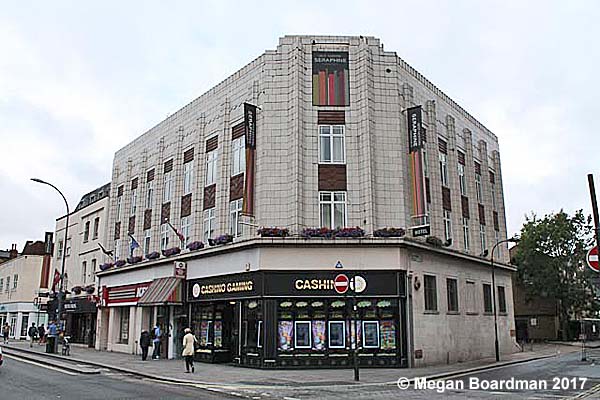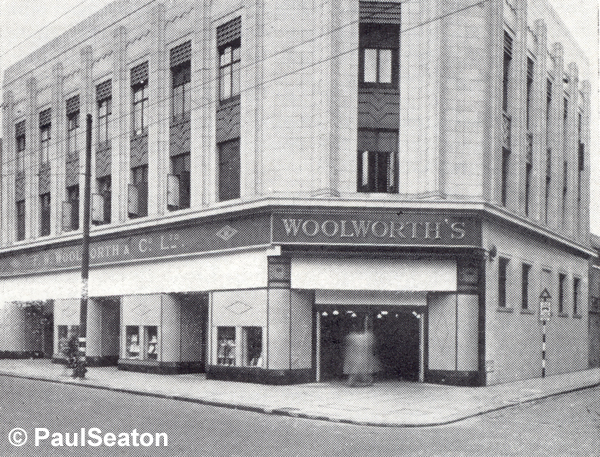84 - 88
King Street, Hammersmith, London

Architect
|
Woolworth's
Company Architect, Mr. B. C. Donaldson
|
Date
Built
|
1937
|
Location
|
84-88 King
Street
|
Description
|
As you can see,
this building on King Street in Hammersmith is
in 2017 a mixed-use property. It is
home, on street level, to an outlet of
KFC and a Casino Gaming Shop. The upper
floors belong to a Best Western Hotel.
However, this Art Deco building has a
past. In 1910, this site was home to the
Hammersmith Cinematograph Theatre, a 490 seat
venue owned and operated by Montague Pike, who
had a fleet of cinemas across London.
Pike declared bankruptcy in 1915 and this
cinema closed and was sold. What
happened next is best explained by Paul
Seaton, the author of "woolworthsmuseum.co.uk"
and 'A Sixpenny Romance, celebrating a
century of value at Woolworths'.
"Woolworth opened at that location in
King Street in 1914, days before the
outbreak of the Great War in a rented
property. It was the 41st to open in the
country, and as such known internally as
Store 41 Hammersmith. As one of the best
performers and most loved stores in the
Country, plans were laid in the early
1920s to systematically redevelop the
site. The Real Estate team negotiated for
the freehold and secretly bought up the
neighbouring properties to achieve a much
wider and deeper footprint. Once the land
was secured, the Company Architect, Mr.
B.C. Donaldson, set to work on an art-deco
design to be finished in portland stone
and marble, with art deco touches to
create a more luxurious finish than on his
other buildings. ....

....... The development must
have been something to behold. The Board
was determined not to allow any loss of
trading during the development, so the new
building was put up around the old one,
with trade transferred into the new
section midway through the project so that
the old building could be pulled down and
replaced before the Upper Floors,
including a popular tea bar and
restaurant, as well large stockrooms and
comfortable staff accommodation could be
added upstairs. The new premises were
opened in stages through the 1930s, with
neon signage added just before World War
II as a response to a 'hated competitor,
which I would be guess would be the
British Home Stores branch which opened
opposite at that time, run by a rival
American consortium.
Weeks after the work was
completed, the building was side-swiped by
the Luftwaffe, causing minor damage to the
facade but destroying the new fascia and
breaking most of windows and damaged the
polished brass window and door frames.
These were hastily repaired/replaced to
make the 'We're carrying on' picture,
which had to be approved by the Censor
before it was published in a special staff
magazine for employees serving in H.M.
Forces. It was among the first in the
country to have a fascia without a
reference to 'Nothing over Sixpence' or
'3D and 6D stores', as the repairs came
days after the chain was forced to drop
its long-standing fixed prices by wartime
inflation.
The branch continued to be profitable
into the 1980s, but the exceptionally high
value of its freehold made it an ideal
candidate for asset-stripping when the
business changed hands in 1982.
Mr Donaldson left the business
in the 1950s. He had designed and overseen
the building of more than 500 branches
over a long career, including some very
nice architecture in the prime locations
(particularly in Church Street Liverpool,
Kensington High Street, Listergate
Nottingham (which is listed) and
Hammersmith. He had a huge influence
on the British street-scape. A surprising
number of his buildings have survived and
been restored, despite most being
mass-produced and built in under four
weeks, exactly as you would expect from
the retailer that once defined
mass-produced goods at affordable prices."
|
Close
Window
|

